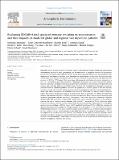| dc.contributor.author | Muntean, Marilena | |
| dc.contributor.author | Janssens-Maenhout, Greet | |
| dc.contributor.author | Zhong, Hui | |
| dc.contributor.author | Zhao, Yu | |
| dc.contributor.author | Olivier, Jos G.J. | |
| dc.contributor.author | Guizzardi, Diego | |
| dc.contributor.author | Crippa, Monica | |
| dc.contributor.author | Schaaf, Edwin | |
| dc.contributor.author | Dentener, Frank | |
| dc.contributor.author | Song, Shaojie | |
| dc.contributor.author | Giang, Amanda Chi Wen | |
| dc.contributor.author | Selin, Noelle E | |
| dc.date.accessioned | 2018-05-15T19:18:41Z | |
| dc.date.available | 2018-05-15T19:18:41Z | |
| dc.date.issued | 2018-04 | |
| dc.date.submitted | 2018-04 | |
| dc.identifier.issn | 1352-2310 | |
| dc.identifier.uri | http://hdl.handle.net/1721.1/115380 | |
| dc.description.abstract | Speciated mercury gridded emissions inventories together with chemical transport models and concentration measurements are essential when investigating both the effectiveness of mitigation measures and the mercury cycle in the environment. Since different mercury species have contrasting behaviour in the atmosphere, their proportion in anthropogenic emissions could determine the spatial impacts. In this study, the time series from 1970 to 2012 of the EDGARv4.tox2 global mercury emissions inventory are described; the total global mercury emission in 2010 is 1772 tonnes. Global grid-maps with geospatial distribution of mercury emissions at a 0.1° × 0.1° resolution are provided for each year. Compared to the previous tox1 version, tox2 provides updates for more recent years and improved emissions in particular for agricultural waste burning, power generation and artisanal and small-scale gold mining (ASGM) sectors. We have also developed three retrospective emissions scenarios based on different hypotheses related to the proportion of mercury species in the total mercury emissions for each activity sector; improvements in emissions speciation are seen when using information primarily from field measurements. We evaluated them using the GEOS-Chem 3-D mercury model in order to explore the influence of speciation shifts, to reactive mercury forms in particular, on regional wet deposition patterns. The reference scenario S1 (EDGARv4.tox2_S1) uses speciation factors from the Arctic Monitoring and Assessment Programme (AMAP); scenario S2 (“EPA_power”) uses factors from EPA's Information Collection Request (ICR); and scenario S3 (“Asia_filedM”) factors from recent scientific publications. In the reference scenario, the sum of reactive mercury emissions (Hg-P and Hg 2+ ) accounted for 25.3% of the total global emissions; the regions/countries that have shares of reactive mercury emissions higher than 6% in total global reactive mercury are China+ (30.9%), India+ (12.5%) and the United States (9.9%). In 2010, the variations of reactive mercury emissions amongst the different scenarios are in the range of −19.3 t/yr (China+) to 4.4 t/yr (OECD_Europe). However, at the sector level, the variation could be different, e.g., for the iron and steel industry in China reaches 15.4 t/yr. Model evaluation at the global level shows a variation of approximately ±10% in wet deposition for the three emissions scenarios. An evaluation of the impact of mercury speciation within nested grid sensitivity simulations is performed for the United States and modelled wet deposition fluxes are compared with measurements. These studies show that using the S2 and S3 emissions of reactive mercury, can improve wet deposition estimates near sources. | en_US |
| dc.publisher | Elsevier | en_US |
| dc.relation.isversionof | http://dx.doi.org/10.1016/j.atmosenv.2018.04.017 | en_US |
| dc.rights | Creative Commons Attribution 4.0 International License | en_US |
| dc.rights.uri | http://creativecommons.org/licenses/by/4.0/ | en_US |
| dc.source | Elsevier | en_US |
| dc.title | Evaluating EDGARv4.tox2 speciated mercury emissions ex-post scenarios and their impacts on modelled global and regional wet deposition patterns | en_US |
| dc.type | Article | en_US |
| dc.identifier.citation | Muntean, Marilena et al. “Evaluating EDGARv4.tox2 Speciated Mercury Emissions Ex-Post Scenarios and Their Impacts on Modelled Global and Regional Wet Deposition Patterns.” Atmospheric Environment 184 (July 2018): 56–68 © 2018 The Authors | en_US |
| dc.contributor.department | Massachusetts Institute of Technology. Center for Global Change Science | |
| dc.contributor.mitauthor | Song, Shaojie | |
| dc.contributor.mitauthor | Giang, Amanda Chi Wen | |
| dc.contributor.mitauthor | Selin, Noelle E | |
| dc.relation.journal | Atmospheric Environment | en_US |
| dc.eprint.version | Final published version | en_US |
| dc.type.uri | http://purl.org/eprint/type/JournalArticle | en_US |
| eprint.status | http://purl.org/eprint/status/PeerReviewed | en_US |
| dc.date.updated | 2018-05-15T14:12:56Z | |
| dspace.orderedauthors | Muntean, Marilena; Janssens-Maenhout, Greet; Song, Shaojie; Giang, Amanda; Selin, Noelle E.; Zhong, Hui; Zhao, Yu; Olivier, Jos G.J.; Guizzardi, Diego; Crippa, Monica; Schaaf, Edwin; Dentener, Frank | en_US |
| dspace.embargo.terms | N | en_US |
| dc.identifier.orcid | https://orcid.org/0000-0001-6395-7422 | |
| dc.identifier.orcid | https://orcid.org/0000-0002-0146-7038 | |
| dc.identifier.orcid | https://orcid.org/0000-0002-6396-5622 | |
| mit.license | PUBLISHER_CC | en_US |
